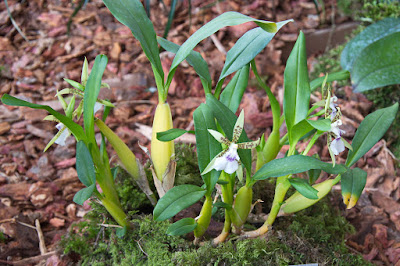Aspasia lunata is native to Brazil. These orchids occur in the colder mountain areas at an altitude of around 1000 m, in the south-eastern states of Rio de Janeiro, Sao Paulo, Minas Gerais, Paraná, Santa Catarina and Rio Grande do Sul...
Aspasia lunata also called as The Moon-Shaped Aspasia, Aspasia lunata var. superba, Aspasia papilionacea, Miltonia odorata, Odontoglossum lunatum, Trophianthus zonatus, is a species of the genus Aspasia. This species was described by John Lindley in 1836.
IDENTIFY ASPASIA LUNATA
Aspasia lunata is native to Brazil. These orchids occur in the colder mountain areas at an altitude of around 1000 m, in the south-eastern states of Rio de Janeiro, Sao Paulo, Minas Gerais, Paraná, Santa Catarina and Rio Grande do Sul. Most often they grow on trees hanging over streams.
It is a small sized, hot to cool growing epiphyte, which reaching 25 cm in height, with strongly laterally compressed, 5-7 cm long and 1.5 cm wide pseudobulbs carrying 2 glabrous, subcoriaceous, lanceolate to ligulate, acute, basally conduplicate and articulate, 20 cm long and 1.0-1.7 cm wide leaves.
The Moon-Shaped Aspasia blooms in the spring on a erect, 9 cm long, 1 to 3 flowered, basal inflorescence. The flowers are about 5.0-6.5 cm tall from the top of the dorsal petal to the lower lip of the lip, and are slightly narrower when measured against the horizontally spread petals of the inner whorl. The star-shaped flowers have petals of both apple-green whorls with spots on the middle at the base in a dark purple-brown to chestnut color. The lip is white with purple or pink-purple spots along the isthmus at the base of the middle plot. The rod is yellowish-white.
ASPASIA LUNATA CARE AND CULTURE
Cultural information should only be used as a guide, and should be to be adapted to suit you. Your physical location; where you grow your plants, how much time you have to devote to their care, and many other factors, will need to be taken into account. Only then can you decide on the cultural methods that best suit you and your plants.
Light:
Aspasia lunata needs a light level of 20000-35000 lux. These plants grow best in bright, but slightly diffused light and need protection from direct southern sun.
Temperature:
It is a plant with moderate thermal requirements. The average temperature of the summer day is 24-26 ° C, the night 17-18 ° C, which gives a daily difference of 7-8 ° C. The average temperature of the winter day is 19 ° C, night 12 ° C, giving a daily difference of 7-8 ° C.
Humidity:
The Moon-Shaped Aspasia needs the humidity of 80-85% from late spring to late autumn, falling to 75% in winter and early spring.
Substrate, growing media and repotting:
You can use any loose medium gradation.
Watering:
In natural habitat, rainfall is relatively abundant for most of the year, but slightly smaller in 2-3 winter months. However, this is not a real dry season. Aspasia lunata should be abundantly watered for most of the year, but the roots should be provided with excellent drainage and air movement.
Fertilizer:
During the active growth, the plants should be fertilized every week 1/4-1 2 of the recommended dose of fertilizer for orchids. A fertilizer with a high nitrogen content is beneficial from spring to mid-summer, and a fertilizer richer in phosphorus should be used in late summer and autumn.
Rest period:
Aspasia lunata need less water from late autumn when they reach maturity by new increments, but they should be watered periodically to protect them from too much drying. In dark, short day conditions, or at lower temperatures, plants need much less water. However, they can not remain without water for too long and they need to be given enough water to prevent the pseudobulbs from wrinkling. Fertilization should be reduced or eliminated until spring, when the growth of new increments begins.















COMMENTS